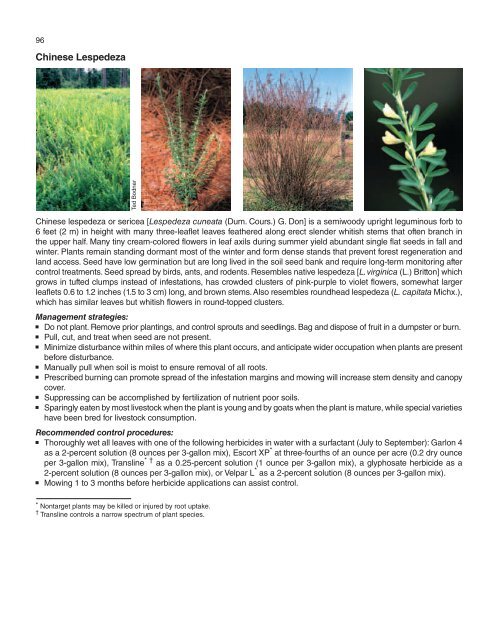A Management Guide for Invasive Plants in Southern Forests James ...
A Management Guide for Invasive Plants in Southern Forests James ...
A Management Guide for Invasive Plants in Southern Forests James ...
- No tags were found...
You also want an ePaper? Increase the reach of your titles
YUMPU automatically turns print PDFs into web optimized ePapers that Google loves.
96Ch<strong>in</strong>ese LespedezaTed BodnerCh<strong>in</strong>ese lespedeza or sericea [Lespedeza cuneata (Dum. Cours.) G. Don] is a semiwoody upright legum<strong>in</strong>ous <strong>for</strong>b to6 feet (2 m) <strong>in</strong> height with many three-leaflet leaves feathered along erect slender whitish stems that often branch <strong>in</strong>the upper half. Many t<strong>in</strong>y cream-colored flowers <strong>in</strong> leaf axils dur<strong>in</strong>g summer yield abundant s<strong>in</strong>gle flat seeds <strong>in</strong> fall andw<strong>in</strong>ter. <strong>Plants</strong> rema<strong>in</strong> stand<strong>in</strong>g dormant most of the w<strong>in</strong>ter and <strong>for</strong>m dense stands that prevent <strong>for</strong>est regeneration andland access. Seed have low germ<strong>in</strong>ation but are long lived <strong>in</strong> the soil seed bank and require long-term monitor<strong>in</strong>g aftercontrol treatments. Seed spread by birds, ants, and rodents. Resembles native lespedeza [L. virg<strong>in</strong>ica (L.) Britton] whichgrows <strong>in</strong> tufted clumps <strong>in</strong>stead of <strong>in</strong>festations, has crowded clusters of p<strong>in</strong>k-purple to violet flowers, somewhat largerleaflets 0.6 to 1.2 <strong>in</strong>ches (1.5 to 3 cm) long, and brown stems. Also resembles roundhead lespedeza (L. capitata Michx.),which has similar leaves but whitish flowers <strong>in</strong> round-topped clusters.<strong>Management</strong> strategies:Do not plant. Remove prior plant<strong>in</strong>gs, and control sprouts and seedl<strong>in</strong>gs. Bag and dispose of fruit <strong>in</strong> a dumpster or burn.Pull, cut, and treat when seed are not present.M<strong>in</strong>imize disturbance with<strong>in</strong> miles of where this plant occurs, and anticipate wider occupation when plants are presentbe<strong>for</strong>e disturbance.Manually pull when soil is moist to ensure removal of all roots.Prescribed burn<strong>in</strong>g can promote spread of the <strong>in</strong>festation marg<strong>in</strong>s and mow<strong>in</strong>g will <strong>in</strong>crease stem density and canopycover.Suppress<strong>in</strong>g can be accomplished by fertilization of nutrient poor soils.Spar<strong>in</strong>gly eaten by most livestock when the plant is young and by goats when the plant is mature, while special varietieshave been bred <strong>for</strong> livestock consumption.Recommended control procedures:Thoroughly wet all leaves with one of the follow<strong>in</strong>g herbicides <strong>in</strong> water with a surfactant (July to September): Garlon 4as a 2-percent solution (8 ounces per 3-gallon mix), Escort XP * at three-fourths of an ounce per acre (0.2 dry ounceper 3-gallon mix), Transl<strong>in</strong>e * † as a 0.25-percent solution (1 ounce per 3-gallon mix), a glyphosate herbicide as a2-percent solution (8 ounces per 3-gallon mix), or Velpar L * as a 2-percent solution (8 ounces per 3-gallon mix).Mow<strong>in</strong>g 1 to 3 months be<strong>for</strong>e herbicide applications can assist control.* Nontarget plants may be killed or <strong>in</strong>jured by root uptake.† Transl<strong>in</strong>e controls a narrow spectrum of plant species.
















